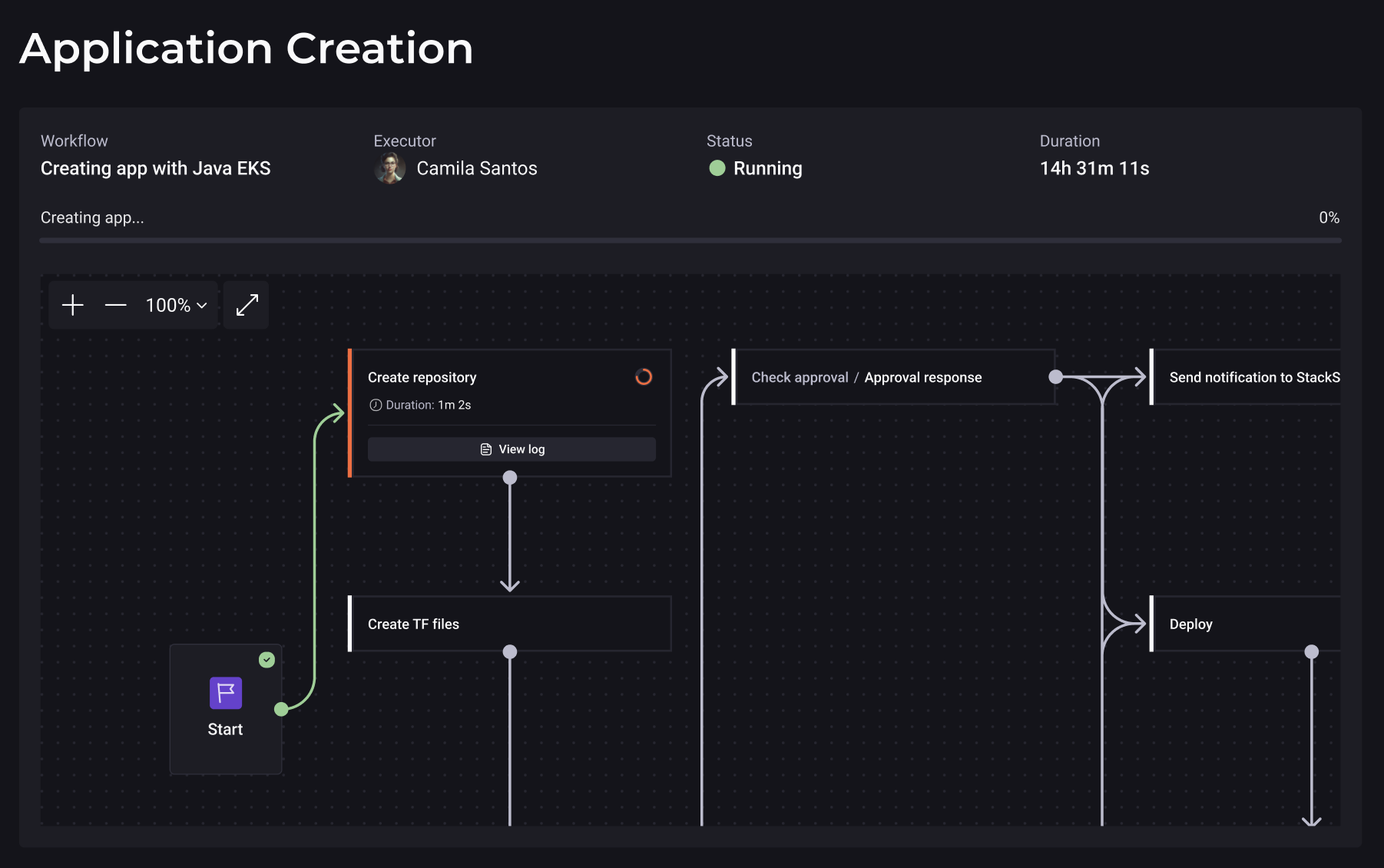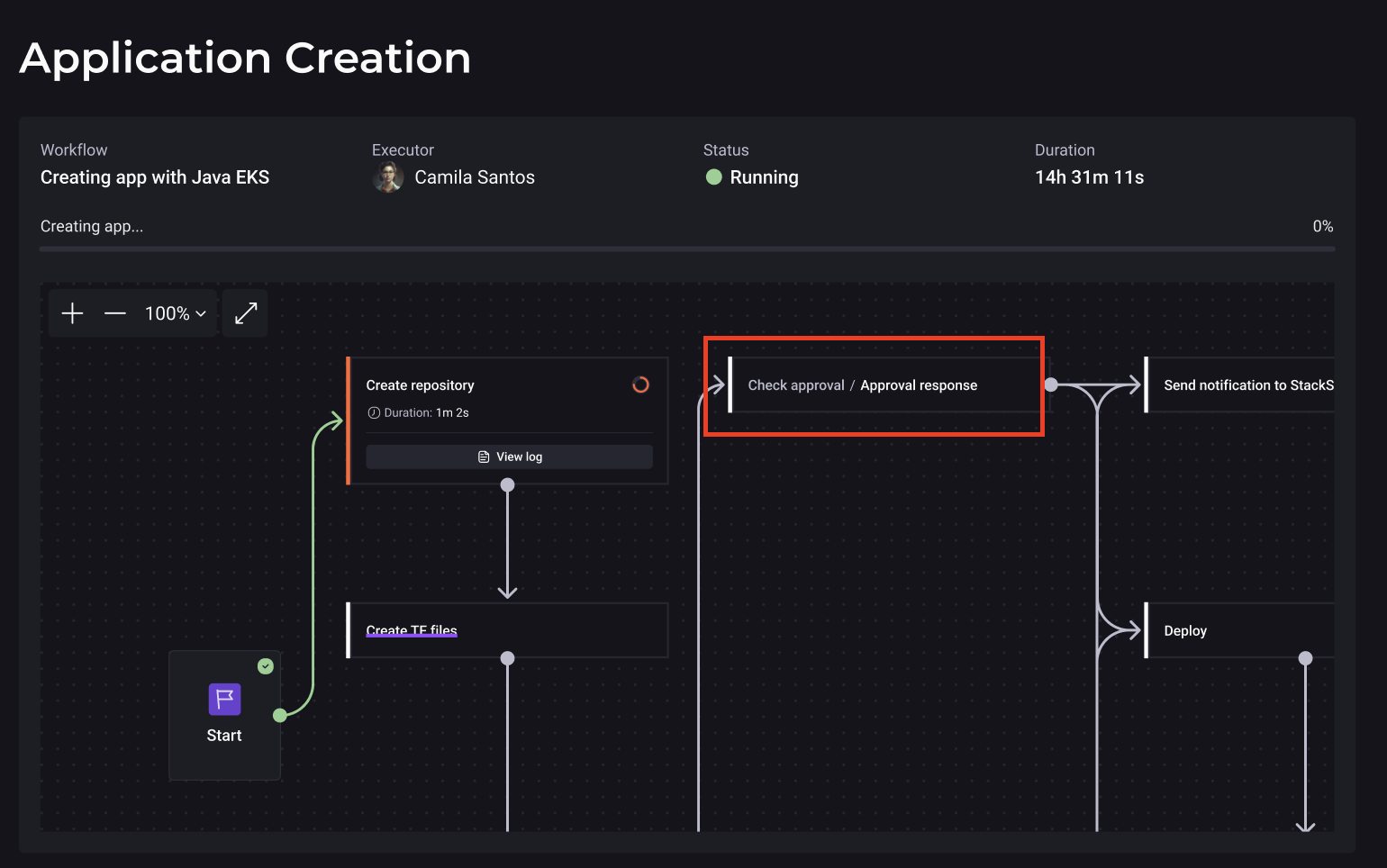Create Application via Portal
Overview
In StackSpot, an Application is any source code that implements business rules or infrastructure as code (IaC), responsible for creating and managing cloud resources.
Applications are developed within Workspaces using tools such as Plugins, Stacks, Starters, or the available Workflows, which make solution development and delivery faster and simpler.
For example, in a bank, an Application can be a system to manage checking accounts, with features such as balance inquiry, transfers, statement issuance, and bill payments. This approach ensures an efficient and complete experience for customers.
In StackSpot, you can create Applications in two ways:
- STK CLI
- StackSpot EDP Portal
To create an Application, you need to use a Stack and a Starter or a Workflow.
It's not possible to create an Application using a deprecated Starter.
Below, you will find the step-by-step guide to create Applications in the Portal using Workflows.
Prerequisites
- Be logged in to a StackSpot account.
- Access a Studio.
- Have a Stack and a Starter.
- Already have environments created.
- Deployment via Self-Hosted already configured to set up and connect environments in your Cloud Account.
- Have SCM configured. This configuration should be performed by the person responsible for administering your account.
- If your account is Enterprise and the administrator decides that users should manage SCM access via PAT (Personal Access Token) individually, you must configure it in 'External Connections'.
If you do not meet any of the prerequisites listed above, pause this guide and access the link corresponding to the pending requirement to resolve it before continuing.
Create Application through the StackSpot Portal
Follow these steps:
Step 1. Log in to the StackSpot EDP Portal;
Step 2. Click the 'Create' button and select the 'Application' option;
-
If the administrator of your Account has not configured SCM, you will not be able to continue. For more information, check the Configure SCM section.
-
If the administrator of your Account has decided that users must manage SCM access via PAT (Personal Access Token) individually, you must configure it in 'External Connections'.
Step 3. Select the Workspace where you want to create the Application;
Step 4. Now, follow the next steps:
- Select a Stack to create the Application;
- Select the Stack version; and
- In Select a Starter: you can choose between Starters or Workflows. To use a Workflow, select the options that start with Creating App with. See an example in the image below:

Step 5. On the 'Application Details' screen, enter your Application data:
- Name: the Application name limit is 60 characters;
- Description: describe what your Application is about; Click the 'Next' button;
Step 6. On the 'Configurations' screen, fill in all the form inputs. The inputs may vary depending on the Workflow.
Then, click the 'Next' button;
-
During the process of creating an Application using a Workflow, you cannot add new Plugins to the Application. However, after creation, you can add and apply new Plugins to the Application.
-
If you have questions while filling in the inputs, refer to the documentation associated with the Stack, Starter, or Workflow you used to create the Application.
-
If there are already configured contexts, some or all variables may be automatically filled. For variables marked as mandatory, it will not be possible to edit them.
Step 6.1. (optional) If you have an Extension configured in your workflow.yaml and, during Application creation, you selected a Starter that has a create-type Workflow, you now need to fill in the fields with the data for the Extension you want to add to your Application.
Step 7. Review your Application information. If necessary, click the 'Edit' button to make adjustments;
Step 8. Click the 'Run' button to push the Application to the repository.
Done! You have created an Application via the StackSpot EDP Portal.
-
When you create the Application through the Portal, it is automatically registered in the Workspace.
-
The Infrastructure deployment of the Application is only performed at this moment if your organization has configured deployment via Runtime Self-Hosted.
-
You must deploy the Application using your pipeline and execute the deployment registration in the StackSpot EDP Portal. This allows you to monitor logs within the Activities screen.
For more details, see the process in the Application Deployment Registration section.
Track the Application Creation Workflow Execution
After clicking the 'Run' button, you will be redirected to the Application creation Workflow tracking screen (Create App). On this screen, you can view and monitor all jobs and steps of the Workflow directly from the platform, as shown in the image below:

- Jobs and steps are interactive and clickable.
- To access the logs, click "View log" on the respective Workflow step.
Workflow Step Approval
Some Workflows include approval steps, which must be accepted to allow the Application deployment to proceed. These steps are displayed on the Workflow tracking screen with the status "Check Approval" or "Approval Response", as shown in the following image:

How to Approve
Approval must be performed by a person with approval permission in the Workspace. This person must access the Application Workflow tracking screen and accept the required approval step(s).
A Workflow may contain multiple approval steps, and each step must be individually accepted for the Workflow to proceed to the next stages.
Execution Details
After creating the Application, you can visually track the execution of your Workflow steps. In addition to visual steps, a field called Execution Details displays detailed information about the steps executed in the Workflow.
The steps are displayed as a list, for example:
- Downloading CLI
- Installing CLI
- Logging into StackSpot
- ...
If any Workflow step is paused, it interrupts the display and resumes after approval, showing the details again. When the Application creation is finished, the 'Execution Details' field closes automatically.
Next Steps
- Register your Application deployment via pipeline.
- Manage and monitor your Application.
- To destroy your Application, check the Destroy section.